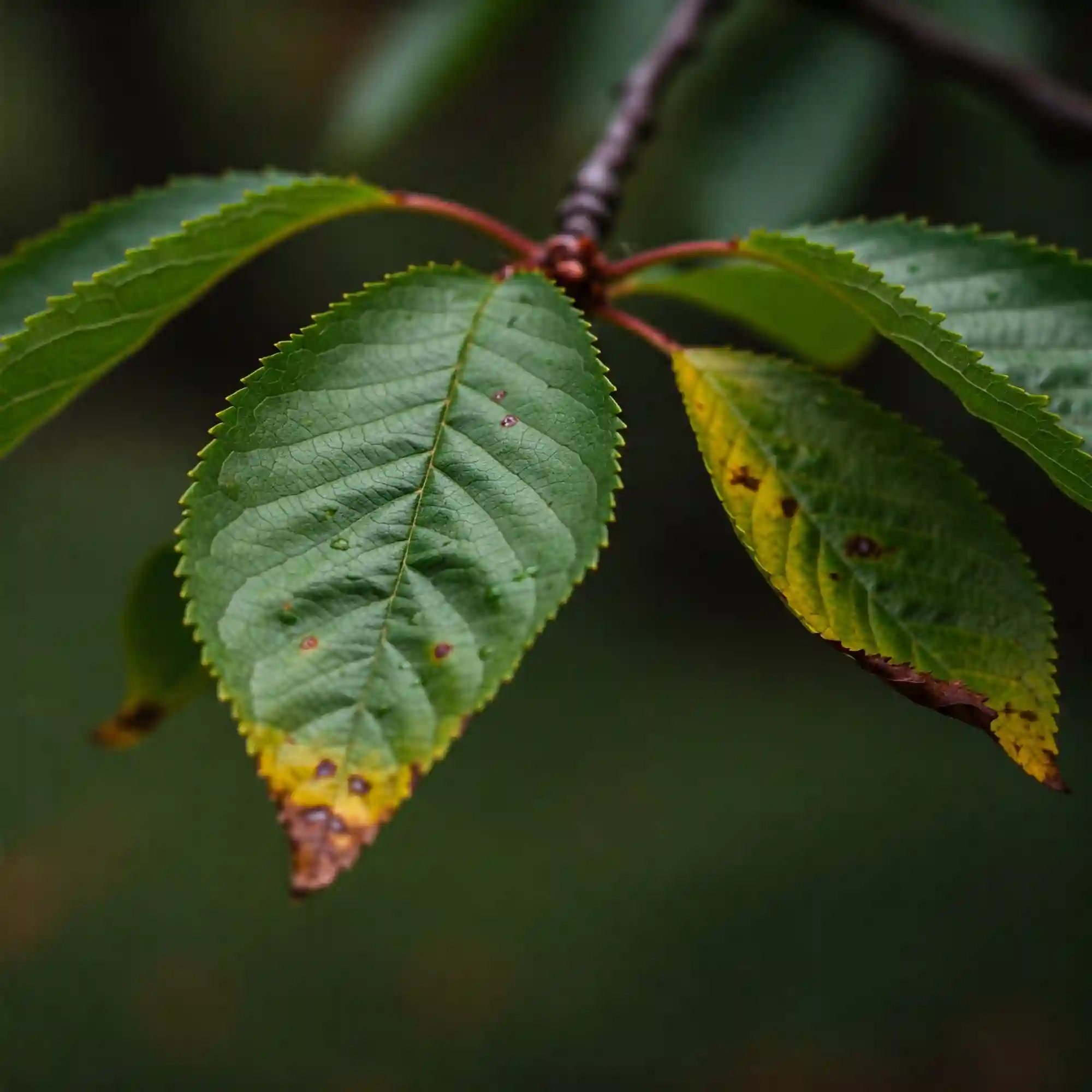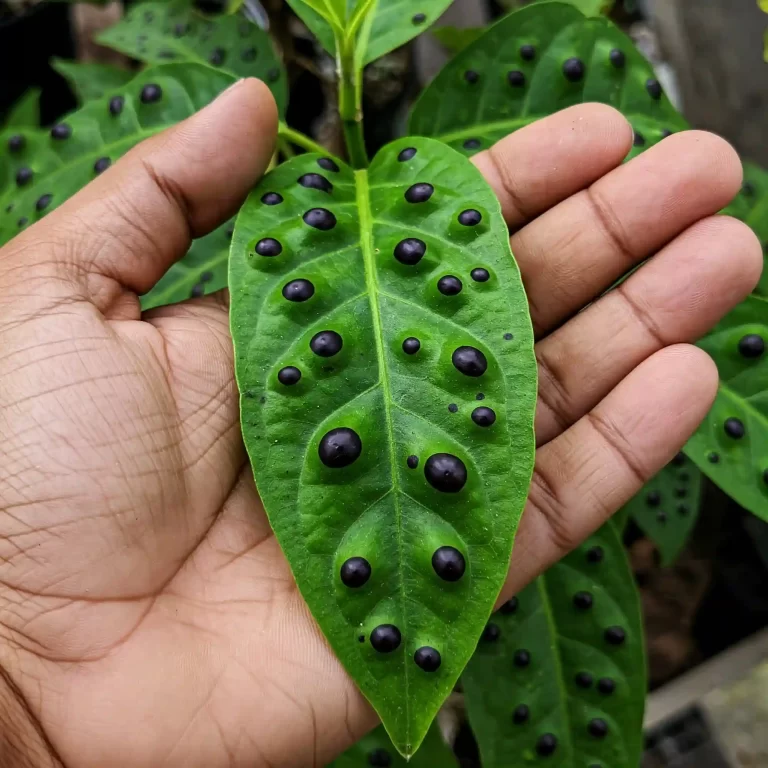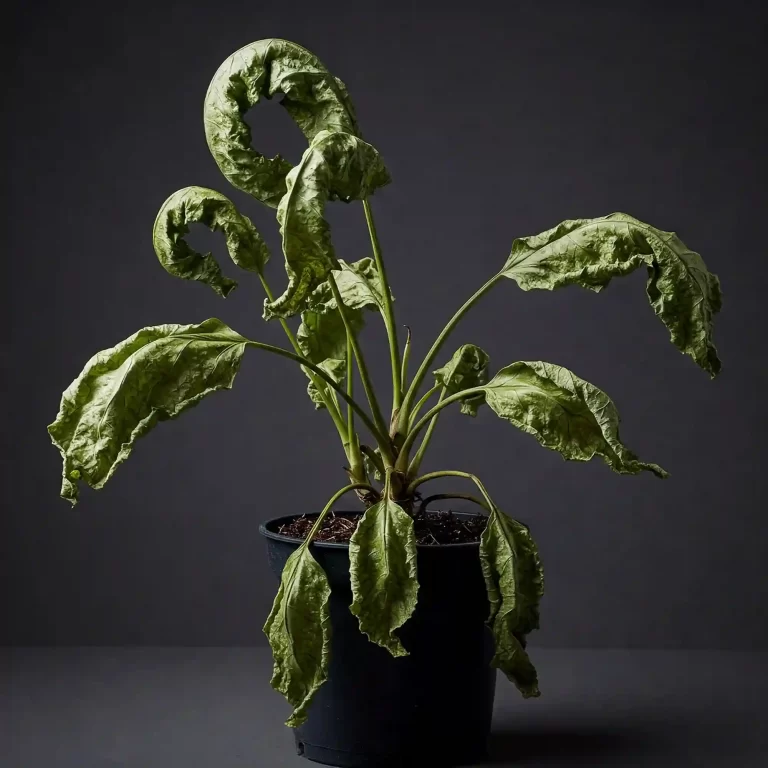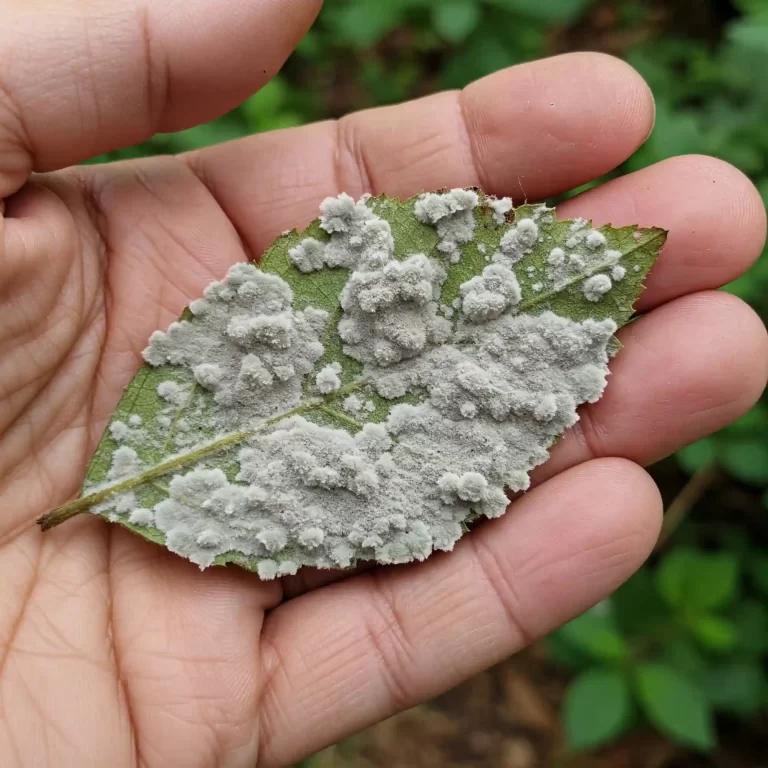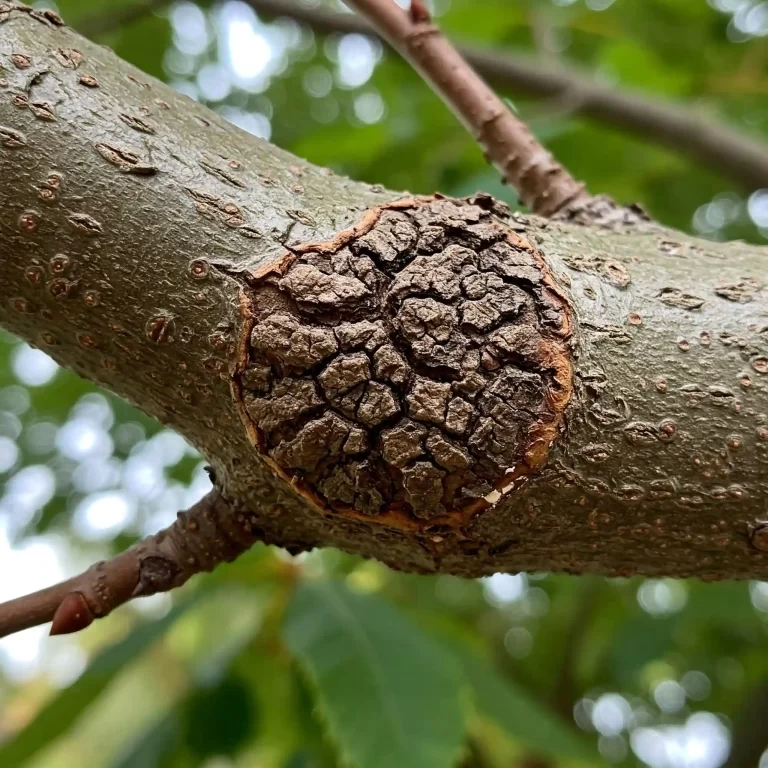Are you noticing subtle changes in your cherry trees—leaves curling, a slight yellowing that just doesn’t seem right? You’ve invested time and effort into your orchard, and the thought of a hidden disease creeping in is unsettling. The fear of losing your precious harvest, of seeing your trees weaken and decline, is a genuine concern. But you’re not alone. I’ve been there, and I understand the anxiety. Let’s tackle this problem head-on by equipping you with the knowledge to spot, prevent, and manage the cherry leaf roll virus (CLRV), ensuring your trees remain healthy and your yields bountiful.
1. Spotting the Silent Threat: Early Symptoms of Cherry Leaf Roll Virus
When you walk through your garden or orchard, you’re looking for signs of life and vitality. But sometimes, a silent threat lurks, and it’s essential to recognize the early symptoms of cherry leaf roll virus (CLRV). I’ve learned that early detection is crucial; it’s the difference between a minor setback and a major loss.
Initial Signs:
The first signs of CLRV are often subtle. You might notice a slight yellowing of the leaves, especially in the spring. This yellowing isn’t a vibrant, healthy hue; it’s more of a muted, almost sickly shade. You’ll also observe that the leaves begin to curl inwards, a telltale sign that something isn’t right.
Detailed Description:
- Leaf Rolling: The leaves don’t just curl; they roll inwards from the edges, forming a somewhat cylindrical shape. This rolling is often accompanied by a stiffening of the leaf tissue.
- Yellowing: The yellowing usually starts along the veins and spreads outwards. This vein clearing, as it’s sometimes called, gives the leaves a mottled appearance.
- Stunted Growth: Young trees, in particular, may exhibit stunted growth. They won’t put on the usual amount of new growth, and the overall vigor of the tree will diminish.
Visual Cues:
When I inspect my trees, I pay close attention to the young leaves. They are often the first to show symptoms. On mature trees, the symptoms may be more subtle, affecting only a portion of the canopy.
What to Look For:
- Pay attention to the color of the leaves. Are they a consistent green, or are there patches of yellow?
- Examine the shape of the leaves. Are they flat, or are they rolled inwards?
- Check the growth rate of your trees. Are they growing at the expected pace, or are they lagging behind?
Case Study:
In one orchard I consulted, the owner initially dismissed the yellowing leaves as a nutrient deficiency. However, upon closer inspection, the leaf rolling was evident. Lab tests confirmed the presence of CLRV. Early detection allowed for prompt action, preventing the virus from spreading to other trees.
Fact:
- CLRV is a member of the nepovirus group, which is known for its wide host range and ability to cause significant damage to fruit trees.
Comparison of Healthy vs. CLRV-Infected Cherry Leaves
| Feature | Healthy Cherry Leaves | CLRV-Infected Cherry Leaves |
| Color | Vibrant green | Yellowing, especially along veins |
| Shape | Flat, normal shape | Rolled inwards from edges |
| Texture | Smooth, flexible | Stiff, slightly thickened |
| Growth | Normal, vigorous | Stunted, reduced growth |
Quote:
“Early detection and prompt action are vital in managing cherry leaf roll virus. Vigilance is your best defense.” – Dr. Eleanor Vance, Plant Pathologist
It’s important to understand that CLRV, a viral infection, can be hard to spot in the early stages. I’ve learned that consistently monitoring your trees is the best way to catch it early. You need to be aware of the signs. You need to know what to look for. You need to check the young leaves. You need to be attentive. You need to act fast.
2. Understanding the Spread: How Cherry Leaf Roll Virus Infects Your Trees
Understanding how CLRV spreads is crucial for effective prevention and management. This virus has a few sneaky ways of moving around, and it’s essential to be aware of each one.
The Role of Nematodes:
Nematodes, tiny worm-like creatures, are the primary vectors for CLRV. These microscopic organisms feed on the roots of cherry trees. When a nematode feeds on a plant infected with CLRV, it acquires the virus. Then, as it moves on to feed on other trees, it transmits the virus, spreading the infection.
Transmission Through Grafting and Infected Plant Material:
Grafting, a common practice in horticulture, can also transmit CLRV. If scion wood or rootstock is taken from an infected tree, the virus can be introduced into the new tree. Similarly, using infected budwood for propagation can spread the disease.
The Role of Pollen:
While less common, pollen can also play a role in CLRV transmission. The virus can be present in the pollen of infected trees, and when this pollen is transferred to healthy trees during pollination, it can introduce the virus.
Understanding the Spread:
- CLRV is primarily spread by nematodes.
- Grafting and the use of infected plant material can transmit the virus.
- Pollen can also play a role in CLRV transmission, though it is less common.
Prevention:
- Use disease-free rootstock and scion wood.
- Avoid using infected budwood for propagation.
- Practice good sanitation in the orchard to minimize the spread of nematodes.
It’s important to remember that CLRV can spread through various means. Understanding these pathways is crucial for implementing effective prevention and management strategies. By being vigilant and taking the necessary precautions, you can protect your cherry trees from this harmful virus.
3. Diagnose with Confidence: Distinguishing CLRV from Other Cherry Tree Diseases
While CLRV is a significant concern, it’s crucial to correctly diagnose the issue. Sometimes, other factors can mimic CLRV symptoms, leading to unnecessary worry or misdirected treatments.
Differentiating CLRV from Fungal Infections and Environmental Stress:
- Fungal Infections: Certain fungal diseases, such as leaf spot and powdery mildew, can cause leaf discoloration and distortion. However, these infections often present with distinct characteristics like powdery white spots (powdery mildew) or dark spots on the leaves (leaf spot). Unlike CLRV, fungal infections can often be treated with appropriate fungicides.
- Environmental Stress: Adverse environmental conditions like drought, nutrient deficiencies, or excessive moisture can also stress cherry trees, leading to leaf discoloration and reduced growth. These symptoms can sometimes resemble CLRV, but they often lack the characteristic leaf rolling and vein clearing associated with the virus.
Specific Diagnostic Techniques:
- Visual Inspection: Careful observation of the leaves, including their color, shape, and texture, is crucial for initial diagnosis. Look for the characteristic leaf rolling, vein clearing, and stunted growth associated with CLRV.
- Laboratory Testing: If you’re unsure about the diagnosis, consider sending leaf samples to a plant diagnostic laboratory. Lab tests can confirm the presence of CLRV and rule out other potential causes.
When to Seek Expert Advice:
- If you suspect CLRV, especially if symptoms are widespread or severe, it’s advisable to consult with a local arborist, plant pathologist, or your county extension office.
- If your cherry trees are exhibiting unusual symptoms, and you’re uncertain about the cause, it’s always best to seek expert advice.
Remember:
- Accurate diagnosis is crucial for effective management.
- Distinguishing CLRV from other potential causes is essential for selecting the appropriate treatment or prevention strategies.
- Consulting with experts can help ensure you make the best decisions for your cherry trees.
4. Protection First: Effective Prevention Strategies for Cherry Leaf Roll Virus
The best defense against CLRV is a strong offense. By implementing proactive prevention strategies, you can minimize the risk of infection and safeguard your cherry trees. Here are some key steps you can take:
Selecting Disease-Free Rootstock:
- When planting new cherry trees, always choose rootstock that is certified to be free of CLRV and other common diseases.
- Reputable nurseries and suppliers often offer disease-tested rootstock.
- Ask your supplier about the origin of the rootstock and inquire about disease testing procedures.
Implementing Quarantine Measures for New Trees:
- When introducing new trees to your orchard or garden, keep them isolated from existing trees for a period of time.
- This helps to prevent the potential spread of CLRV or other diseases if the new trees are unknowingly infected.
- Observe the new trees closely for any signs of disease during the quarantine period.
Sanitation Techniques to Prevent Vector Spread:
- Control Nematodes: Nematodes are the primary vectors for CLRV. Implementing good soil management practices can help to control nematode populations. This may include crop rotation, using resistant rootstocks, and applying nematicides (if necessary and permitted in your region).
- Monitor and Control Aphids: While aphids are not the primary vectors, they can also transmit CLRV. Monitor your trees for aphid infestations and take appropriate control measures, such as applying insecticidal soap or using beneficial insects like ladybugs.
- Sanitation Practices: Clean and disinfect pruning tools between cuts to prevent the spread of the virus. Remove and destroy any severely infected branches or trees to minimize the source of infection.
Additional Tips:
- Keep your orchard or garden clean and weed-free. Weeds can harbor pests and diseases that can affect your cherry trees.
- Avoid overcrowding trees, as this can create a more favorable environment for the spread of diseases.
- Regularly inspect your trees for any signs of disease, including CLRV. Early detection is key to effective management.
By implementing these prevention strategies, you can significantly reduce the risk of CLRV infection in your cherry trees. Remember, prevention is always better than cure.
5. Control Measures: Managing Infected Cherry Trees and Orchards
If you discover that your cherry trees are infected with CLRV, it’s important to take action to manage the disease and prevent further spread. While there is no cure for CLRV, there are several management strategies you can implement.
Pruning and Removal of Severely Infected Branches:
- Pruning: Carefully prune out any branches that show severe symptoms of CLRV. This helps to reduce the viral load within the tree and can slow the progression of the disease.
- Removal of Severely Infected Trees: In cases of severe infection where the tree’s overall health is compromised, removal of the entire tree may be necessary. This is a difficult decision, but it can help to prevent the further spread of the virus to other trees.
Vector Control:
- Control Nematodes: Nematodes are the primary vectors of CLRV. Implementing good soil management practices can help to control nematode populations. This may include crop rotation, using resistant rootstocks, and applying nematicides (if necessary and permitted in your region).
- Monitor and Control Aphids: While aphids are not the primary vectors, they can also transmit CLRV. Monitor your trees for aphid infestations and take appropriate control measures, such as applying insecticidal soap or using beneficial insects like ladybugs.
Other Management Strategies:
- Sanitation: Maintain good sanitation practices in your orchard or garden. This includes removing and destroying any fallen leaves or fruit from infected trees.
- Tree Health: Ensure that your cherry trees are healthy and vigorous. Healthy trees are better able to withstand the effects of CLRV. Provide adequate water, fertilization, and pest control.
- Monitoring: Continuously monitor your trees for any signs of disease, including CLRV. Early detection and prompt action are crucial for effective management.
Remember:
- Managing CLRV requires a multi-faceted approach.
- Combining pruning, vector control, and sanitation practices can help to minimize the impact of the virus on your trees.
- It’s important to consult with local experts for specific recommendations based on your region and the severity of the infection.
6. Long-Term Impact: What CLRV Means for Your Cherry Yield and Tree Health
While CLRV may not immediately cause the death of your cherry trees, it has a significant impact on their long-term health and productivity. Understanding these consequences is crucial for making informed management decisions.
Reduced Fruit Yield:
- One of the most noticeable impacts of CLRV is a reduction in fruit yield. Infected trees produce fewer cherries, and the size and quality of the fruit may also be affected.
- The virus can weaken the tree, making it less productive and more susceptible to other stresses.
Impact on Tree Health:
- CLRV can weaken the overall health of the tree, making it more susceptible to other diseases, pests, and environmental stresses.
- Severely infected trees may exhibit stunted growth, dieback of branches, and eventually decline and death.
Economic Impact:
- Reduced fruit yield and tree health can have a significant economic impact on orchards.
- Lower yields translate to reduced income for growers.
- The cost of managing the disease, including implementing control measures and replacing infected trees, can also be substantial.
Long-Term Implications:
- CLRV is a persistent virus that can remain in infected trees for many years.
- The virus can continue to spread within the orchard, infecting more trees over time.
- If left unchecked, CLRV can have a devastating impact on the long-term productivity and viability of a cherry orchard.
Understanding the Long-Term Effects:
- It’s important to recognize that CLRV is a serious disease that can have long-lasting consequences.
- Early detection and prompt management are crucial to minimizing the impact of the virus on your trees and your orchard’s productivity.
- By taking proactive steps to prevent and manage CLRV, you can protect your investment and ensure the long-term health and sustainability of your cherry orchard.
7. Choosing Resilience: Are There Cherry Cultivars Resistant to CLRV?
While there is no single cherry cultivar that is completely immune to CLRV, some varieties exhibit greater resistance to the virus than others. Planting resistant cultivars is a valuable strategy for managing CLRV and protecting your orchard.
Exploring Available Cherry Cultivars with CLRV Resistance:
Researchers and breeders have been working to develop cherry cultivars with increased resistance to CLRV. Some promising varieties have shown higher tolerance to the virus, resulting in reduced disease severity and better overall tree health.
- Identifying Resistant Cultivars: Consult with your local extension service or agricultural specialists to identify CLRV-resistant cherry cultivars that are well-suited to your region and growing conditions.
Benefits of Using Resistant Varieties:
- Reduced Disease Severity: Resistant cultivars can significantly reduce the severity of CLRV infection, leading to fewer symptoms and less impact on tree health.
- Improved Fruit Yield: Trees with greater resistance to CLRV tend to produce higher yields of fruit, even in the presence of the virus.
- Enhanced Tree Health: Resistant cultivars are better able to withstand the effects of CLRV, maintaining overall tree vigor and longevity.
Limitations of Resistant Varieties:
- No Complete Immunity: It’s important to remember that even resistant cultivars are not completely immune to CLRV. They may still exhibit some level of infection, especially under high disease pressure.
- Availability: The availability of CLRV-resistant cultivars can vary depending on your region.
- Cost: Resistant cultivars may be more expensive than standard varieties.
Selecting Suitable Cultivars for Your Region:
- Consider factors such as climate, soil conditions, and your specific growing objectives when selecting resistant cultivars.
- Consult with local experts to determine which varieties are best suited for your region and growing conditions.
- Look for cultivars that have been evaluated and shown to have good resistance to CLRV.
Remember:
- Planting resistant cultivars is an important component of a comprehensive CLRV management strategy.
- It’s essential to combine the use of resistant varieties with other management practices, such as sanitation and vector control, to maximize protection.
- Consult with local experts to make informed decisions about cultivar selection and management.
8. Regional Insights: CLRV Prevalence and Control in Your Area
The prevalence and severity of CLRV can vary significantly depending on your location. Understanding the specific challenges and recommendations for your region is crucial for effective management.
Identifying Regional Patterns and Prevalence of CLRV:
- CLRV is a globally distributed virus, affecting cherry-growing regions worldwide.
- The prevalence of the virus can vary depending on factors such as climate, soil conditions, and the presence of vector populations.
- Some regions may have higher CLRV prevalence due to factors like the presence of susceptible cultivars, high nematode populations, or favorable environmental conditions for disease spread.
Local Resources and Extension Services for Assistance:
- Your local agricultural extension service is an invaluable resource for information on CLRV and other cherry tree diseases.
- Extension agents can provide you with:
- Information on CLRV prevalence in your region.
- Recommendations for CLRV management strategies tailored to your specific growing conditions.
- Access to diagnostic services for suspected CLRV infections.
- Information on available resistant cultivars and other management options.
Specific Control Recommendations Tailored to Your Region:
- Control measures may need to be adjusted based on the specific challenges and conditions in your region.
- For example, if nematode populations are high in your area, implementing nematode control measures may be a priority.
- If CLRV is particularly prevalent in your region, you may need to adopt more stringent sanitation practices and consider using resistant cultivars.
Building a Relationship with Local Experts:
- Establishing a relationship with your local extension service and other agricultural experts can provide you with ongoing support and guidance.
- They can answer your questions, provide up-to-date information on CLRV management, and help you troubleshoot any problems you encounter.
Remember:
- CLRV management strategies can vary depending on your location.
- Consulting with local experts is crucial for obtaining specific recommendations and tailoring your management approach to your region’s unique conditions.
By understanding the regional context of CLRV and utilizing the resources available to you, you can effectively manage the disease and protect your cherry trees.
FAQ
Here are some frequently asked questions about Cherry Leaf Roll Virus (CLRV) to help you better understand and manage this disease:
Q: How to identify early symptoms of cherry leaf roll virus?
A: Early symptoms of CLRV can be subtle. Look for:
- Yellowing of leaves: This is often the first sign, starting as a faint yellowing along the veins and gradually spreading.
- Leaf rolling: The leaves begin to curl inwards, forming a somewhat cylindrical shape.
- Stunted growth: Young trees may exhibit reduced growth compared to healthy trees.
Q: What are the best methods for preventing cherry leaf roll virus spread?
A: Prevention is key! Here are some effective strategies:
- Use disease-free rootstock: Purchase rootstock from reputable sources that have been tested for CLRV.
- Quarantine new trees: Isolate newly planted trees from existing trees for a period to monitor for any signs of disease.
- Control nematode populations: Nematodes are the primary vectors of CLRV. Implement soil management practices like crop rotation and nematode control measures if needed.
- Sanitation practices: Disinfect pruning tools between cuts and remove and destroy any infected branches or trees.
Q: Effective treatments for cherry trees infected with leaf roll virus?
A: Unfortunately, there is no cure for CLRV. However, management strategies can help minimize its impact:
- Pruning: Remove severely infected branches to reduce the viral load within the tree.
- Vector control: Implement measures to control nematodes and other potential vectors.
- Tree health: Ensure your trees are healthy and vigorous through proper irrigation, fertilization, and pest control.
Q: Understanding the long-term effects of cherry leaf roll virus on yield?
A: CLRV can significantly reduce fruit yield. Infected trees may produce fewer cherries, and the size and quality of the fruit may be affected. The virus can also weaken the tree, making it less productive and more susceptible to other stresses.
Q: Regional prevalence and control of cherry leaf roll virus in orchards?
A: The prevalence of CLRV varies by region. Contact your local agricultural extension service for information specific to your area. They can provide insights into local prevalence, recommended management strategies, and available resources.
Q: What are the nematode vectors that transmit cherry leaf roll virus?
A: Dagger nematodes are the primary vectors of CLRV. These microscopic organisms feed on the roots of cherry trees and transmit the virus as they move from tree to tree.
Q: How to distinguish cherry leaf roll virus from other cherry tree diseases?
A: Carefully observe the symptoms. CLRV is characterized by leaf rolling and vein clearing, which may not be present in other diseases. Consult with a plant pathologist or your local extension service for accurate diagnosis.
Q: Best practices for managing cherry leaf roll virus in home gardens?
A: For home gardeners, prevention is key. Select disease-free trees, practice good sanitation, and monitor your trees regularly for any signs of infection. If you suspect CLRV, consult with a local expert for advice.
Q: Are there cherry tree cultivars resistant to cherry leaf roll virus?
A: Yes, some cherry cultivars exhibit greater resistance to CLRV. Consult with your local nursery or extension service for recommendations on resistant varieties suitable for your region.1
Q: Detailed guide for diagnosing cherry leaf roll virus on young trees?
A: Pay close attention to young leaves for signs of yellowing and rolling. If you suspect CLRV, consult with a plant pathologist for confirmation.
Remember, early detection and prompt action are crucial for managing CLRV and protecting your cherry trees. If you have any further questions or concerns, don’t hesitate to reach out to your local agricultural extension service or a qualified arborist.
Conclusion:
Protecting your cherry trees from CLRV requires a multi-faceted approach that combines prevention, early detection, and effective management strategies. By understanding the symptoms, spread, and control measures, you can safeguard your harvest and ensure the long-term health of your orchard. Remember, vigilance, early detection, and a proactive approach are your best defenses against this challenging disease.
Key Takeaways:
- Early detection is crucial: Monitor your trees regularly for any signs of CLRV, such as leaf rolling and yellowing.
- Prevention is key: Implement strategies like using disease-free rootstock, practicing good sanitation, and controlling nematode populations.
- Management strategies: If infection occurs, implement management strategies such as pruning, vector control, and removing severely infected trees.
- Resistant cultivars: Consider planting CLRV-resistant varieties to minimize disease impact.
- Consult with experts: Seek guidance from your local extension service or other agricultural experts for specific recommendations tailored to your region.
Additional Resources:
- Your local agricultural extension service
- State Department of Agriculture
- University plant pathology departments
- Online resources from reputable horticultural organizations
By implementing the strategies outlined in this guide and utilizing the resources available to you, you can effectively manage CLRV and enjoy healthy, productive cherry trees for years to come.
Remember, protecting your trees is an ongoing process. Stay informed about the latest research and management practices to adapt your strategies as needed. With careful attention and proactive management, you can overcome the challenges posed by CLRV and continue to enjoy the sweet rewards of a successful cherry harvest.
